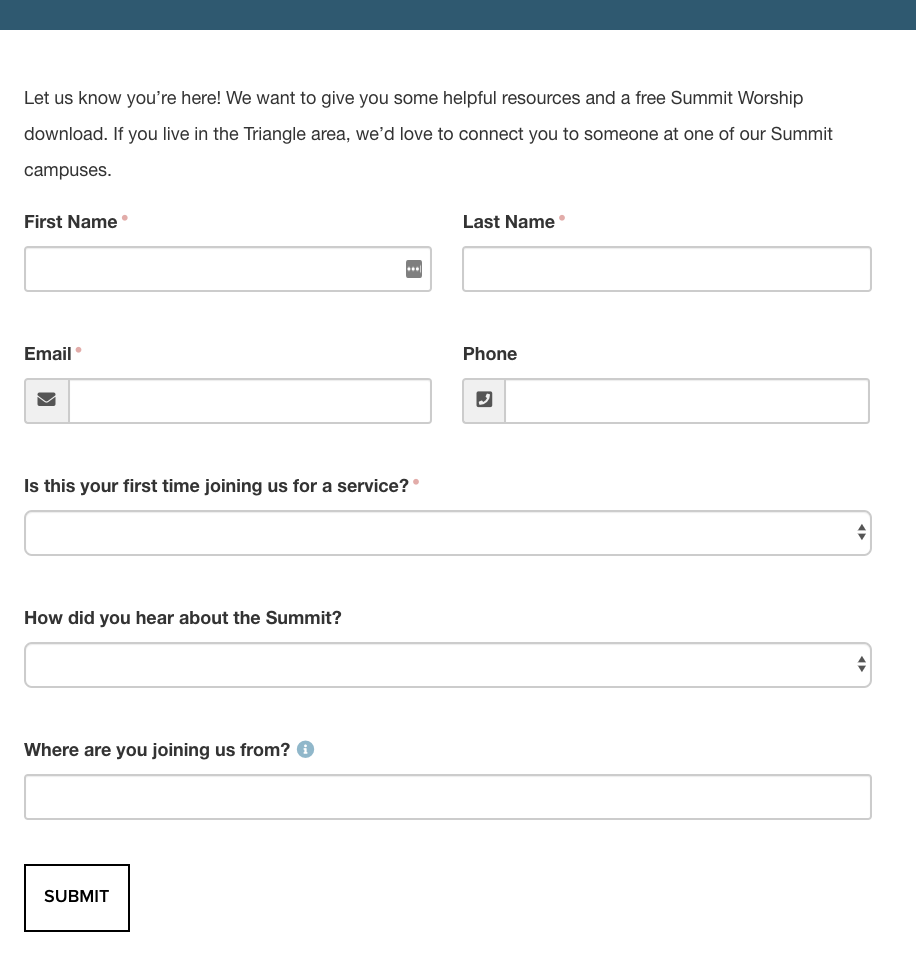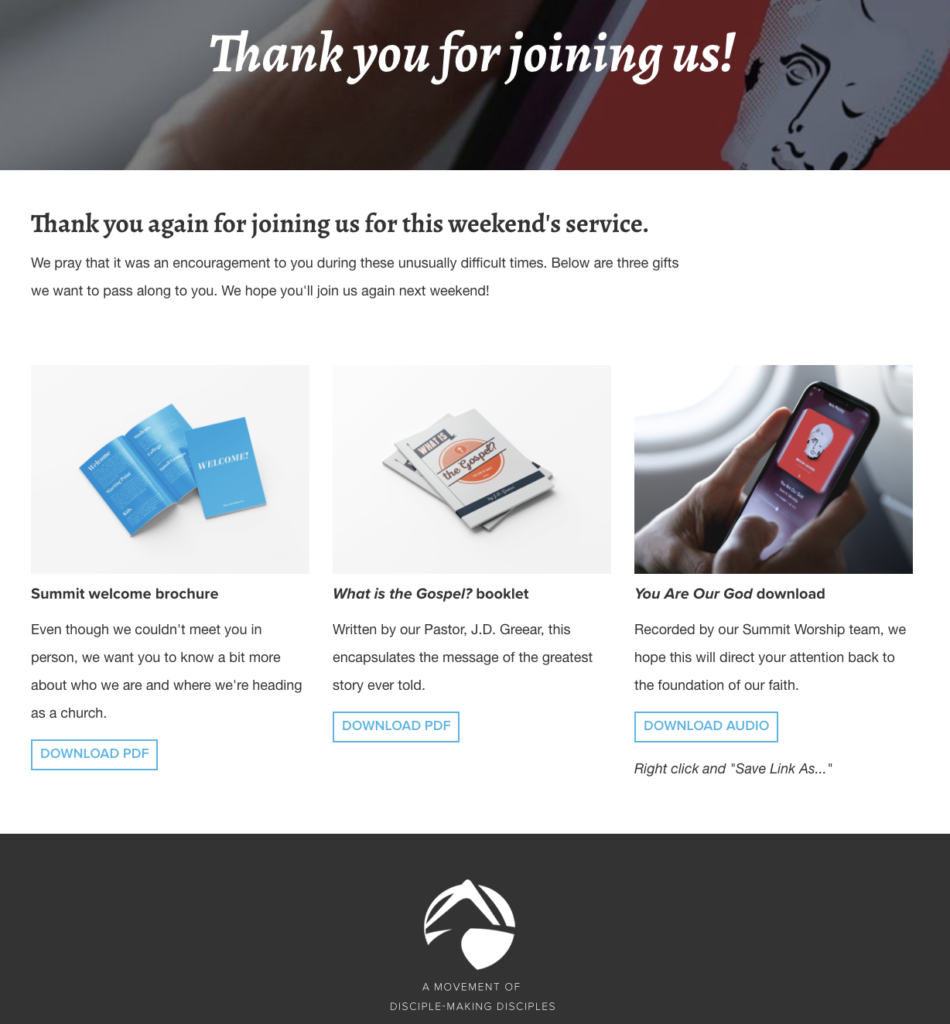Be Our (Virtual) Guest: What We’re Learning

Let’s start with the hopefully-obvious point: yesterday was April 1. April Fool’s Day. If you read the rare Wednesday post and thought our brand-new Quaranteenies™ idea was stupid, I have good news and bad news. The good news: it was a joke. The bad news: maybe you should rethink going online, and definitely avoid emails from Nigerian royalty.
But there’s always some truth in every joke, and the truth is, we are all rethinking how we connect with our guests in an online-only environment. If there’s one question that’s been batted around between me and other church staff friends from around the country recently, it’s this one.
The last few weeks have been a lot of trial and mostly error on our end, so if you came here looking for solid answers and one-size-fits-all solutions, you might want to head elsewhere, unless you like slow motion train wrecks or a list of what not to do.
But if you’re interested in seeing how a real church is struggling in real ways with the new reality, here’s our timeline (note: I’ll update these each week as we make our way through this) :
Weekend 1 (March 14-15): fail.
Our executive team made the decision late Thursday afternoon to go online-only and record the service on Friday morning. That fast turnaround made a new plan almost impossible. And if I’m being totally transparent here: in those first few hours / days, a lot of my focus had nothing to do with our online services. I knew that other people on our team were taking care of that. But as the days rolled on and the inevitability of a longer lockdown began to take shape, I knew it was something we needed to focus on.
First-time guest count: 0
Weekend 2 (March 21-22): fail.
We rolled into the second weekend with a Band-Aid plan: something that would serve as a temporary patch while we came up with a more robust cure. Our communications team recruited moderators for our four online services that weekend, and they were tasked with interacting with those who identified themselves as guests.
The plan was for moderators to fish out that information, get contact info from the guest in question, and put them in a spreadsheet that would then get divided up among the staff for follow-up.
It was a disaster.
Guests (obviously) did not want to share an email address or phone number in a chat box on Facebook or YouTube. We had five people who identified themselves as guests. Only two of them gave us information about where they lived. Only one was in-town. And none gave us actionable contact info so that we could follow up later.
First-time guest count: five? 0
Weekend 3 (March 28-29): not-quite-a-fail.
The overwhelming feedback from our weekend 2 moderators told us what we’d finally figured out: guests were not going to give up their personal info via chat. So for weekend 3 we developed a first-time guest form linked to a simple url. We sprinkled that url liberally in chat conversations and pre-service announcements.
Here’s what the form looks like (click here if you’re reading via rss feed or email subscription):

Filling out that form did two things: it redirected them to a digital version of our first-time guest bag. The brochure and booklet was replaced with a pdf version, and the cup was replaced with a free Summit Worship download. We pitched these freebies as an incentive to get information.
The second action from the form set off a workflow in our database which allowed us to assign guests to staff members for follow up. Those conversations have already elicited opportunities for prayer and connection to a local campus. (All out of town guests are currently going to one staff member who is still reaching out, checking in, and offering to pray for them in light of the current situation.)
Because the email address was required on the form, it gave us an actionable way to touch base with the guest after their visit, and will allow us to invite them to join us when we begin to gather in person again.
(click here if you’re reading via rss feed or email subscription):

First-time guest count: 7
Weekend 4 (April 4-5): improving.
We made the simple url a little bit more pronounced: our pastor mentioned it as a part of his pre-sermon banter…always valuable real estate when it comes to announcements. And we dropped that link in on screen any time it was mentioned…a good visual reinforcement to help people take a step. Our numbers doubled…still not what a “normal” weekend would look like (it’s not unusual for us to have 100 or more first timers identify themselves at our first-time guest tent), but better than it has been.
First-time guest count: 16
Weekend 5 (Easter, April 11-12): #comeandsee
The url gained momentum this weekend. Not only did we have more than triple the FTG count of any previous weekend, we also (finally) tipped the scales to have more in town than out of town guests.
In addition to putting lots of eyes on the url, we utilized a text-in-your-decision option in the service. I’ll have a full report on that in a post later this week.
First-time guest count: 52
Weekend 6 (April 18-19)
We saw a 75% jump in FTG numbers from the weekend before Easter. Our in town vs. out of town count was back to old habits (11 in town, 14 out of town, 3 unknown).
First-time guest count: 28
Weekend 7 (April 25-26)
This weekend we pulled out our secret weapon: Adon Greear, the manchild of our pastor (see the video below or click here). I gladly cede my role as the Guest Services guy to this young wunderkind:
First-time guest count: 37
Weekend 8 and beyond: TBD
I will continue to update this page as more resources get added to our process. Meanwhile, see this post for more.
How are you connecting your online guests? I want to hear your best practices. Comment below.

We are using an online connect card with a QR reader on the screen. Just scan the code with your phone and it takes you to an online form. We also have a number that people can text the words, CONNECT, GIVE, or SERVE. It’s quick and easy.
I love it, Mary! What service are you using for the text-in option?
I believe it is called “Pastor’s Line.”